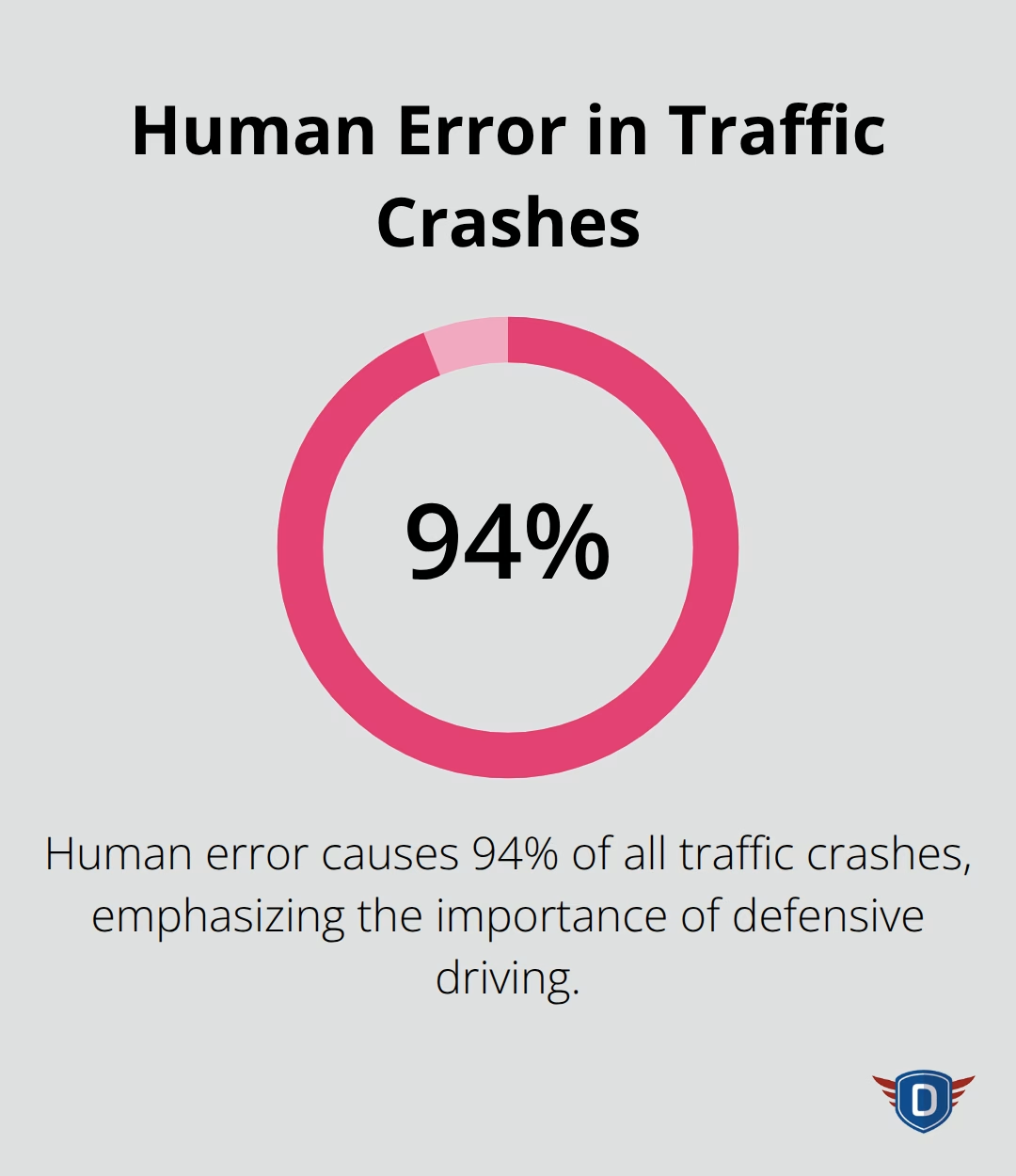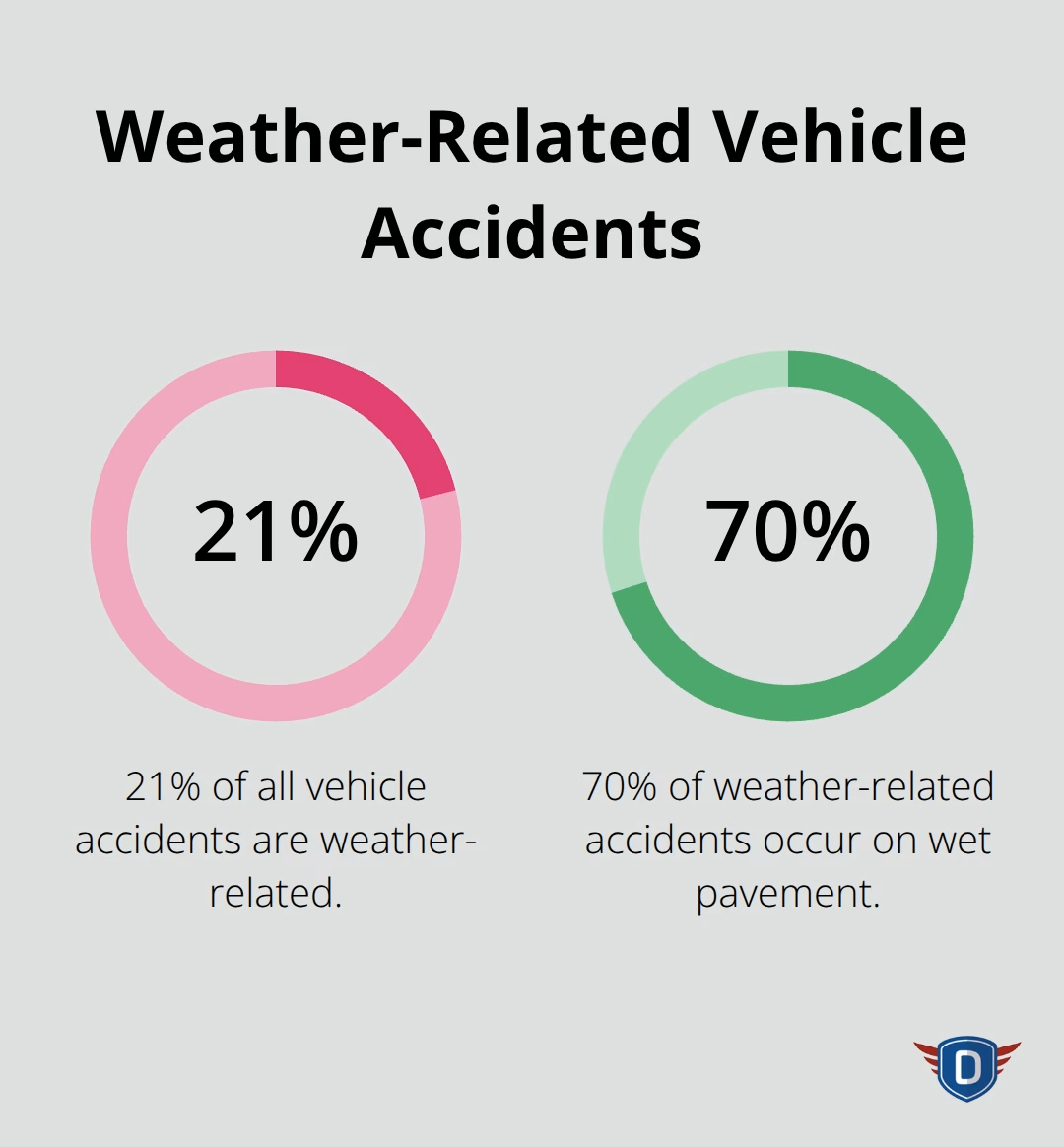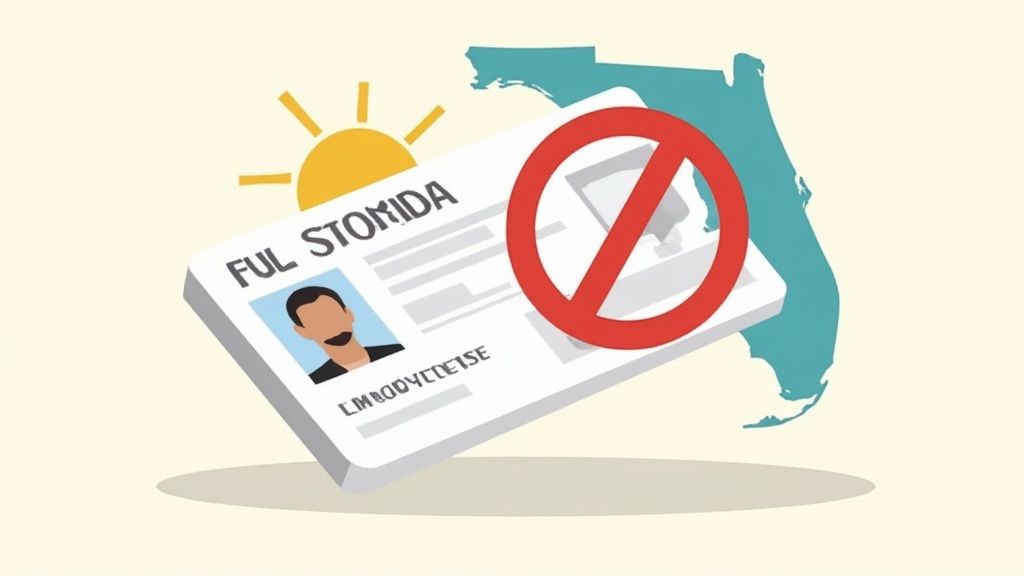Every year, defensive driving prevents over 2.5 million accidents across American roads. The National Safety Council reports that drivers who practice defensive techniques reduce their crash risk by 40%.
Which of the following is a key to defensive driving? Anticipation, awareness, and proper response to road hazards form the foundation. We at DriverEducators.com break down these essential skills to keep you protected behind the wheel.
What Makes Defensive Driving Different
Defensive driving operates on three non-negotiable principles that separate safe drivers from accident statistics. The Federal Motor Carrier Safety Administration defines defensive driving as the practice of anticipating dangerous situations and making well-reasoned decisions to avoid crashes. This approach demands constant awareness of your surroundings, safe distance maintenance, and preparation for unexpected actions from other drivers.
The Numbers Behind Defensive Techniques
The National Highway Traffic Safety Administration reports that human error causes 94% of all traffic crashes, which makes defensive driving skills your strongest protection.

Drivers who complete defensive driving courses show measurable accident reduction benefits. Motor vehicle accidents cost U.S. businesses $72.2 billion annually in medical care, liability, and lost productivity. Companies that implement defensive driving training see measurable reductions in these costs within the first year of program implementation.
Offensive vs Defensive Approaches
Offensive drivers focus on speed, aggression, and advancement through traffic at any cost. They tailgate, weave between lanes, and ignore safety margins. Defensive drivers prioritize safety over speed, maintain proper distances of 3-4 seconds (approximately one car length per 10 mph), and scan the road ahead for potential hazards. While offensive drivers may save a few minutes on their commute, they increase their crash risk exponentially. The Insurance Institute for Highway Safety found that aggressive behaviors contribute to 56% of fatal crashes, while defensive drivers experience lower insurance premiums and fewer traffic violations.
Core Skills That Matter
Successful defensive drivers master three fundamental skills that transform their road safety. Anticipation allows drivers to predict potential hazards before they develop into emergencies. Awareness keeps drivers alert to changing conditions, other vehicles, and environmental factors. Response preparation enables quick, appropriate reactions when dangerous situations arise (such as sudden stops or lane changes by other drivers).
These skills work together to create a comprehensive safety approach that extends far beyond basic traffic rule compliance, setting the foundation for specific techniques that every driver must master.
How Do You Master Distance and Speed Control
The three-second rule forms the backbone of safe following distances, but this baseline changes dramatically with conditions.

At 55 mph, three seconds equals 240 feet of stopping distance, while wet roads require drivers to double this distance to six seconds. Studies show that maintaining proper following distances consistently reduces rear-end collision risks significantly.
Speed control goes beyond posted limits. Defensive drivers reduce speed by one-third in rain and by half in snow conditions. Modern vehicles need 120 feet to stop from 55 mph on dry pavement, but this distance triples on icy roads.
Advanced Road Scanning Methods That Work
Professional drivers scan 12-15 seconds ahead at highway speeds, which translates to a quarter-mile of road visibility. The Smith System teaches drivers to check mirrors every 5-8 seconds and scan intersections in a specific pattern: left, right, then left again before proceeding.
Peripheral vision covers 180 degrees, but drivers only process details in the central 3-degree cone of sharp focus. Effective hazard recognition requires systematic eye movement patterns that cover blind spots, side mirrors, and potential conflict zones. Research by the American Automobile Association shows that drivers who practice structured visual checks reduce accident rates by 35% compared to those who rely on random observation patterns.
Mirror Management and Blind Spot Elimination
Standard mirrors create blind spots that span 15-20 feet on each side of your vehicle at highway speeds. Proper mirror adjustment eliminates these gaps entirely – side mirrors should show minimal vehicle reflection and maximum road coverage. The National Highway Traffic Safety Administration recommends that drivers adjust mirrors while seated in normal position, then check blind spots physically before every lane change.
Blind spot monitoring systems fail 8% of the time according to Insurance Institute for Highway Safety tests, which makes visual confirmation mandatory. Commercial drivers check mirrors every 5-8 seconds as standard practice (a habit that reduces side-impact crashes by 40% when all drivers apply it consistently).
These distance and speed control techniques provide the foundation for handling the specific road hazards that challenge even experienced drivers daily.
What Road Hazards Require Immediate Response
Weather-related crashes account for significant dangers on the road, with over 268,000 people injured in weather-related crashes each year according to Federal Highway Administration data. The National Highway Traffic Safety Administration data shows that weather-related crashes account for 21% of all vehicle accidents annually, with 70% occurring on wet pavement.

Smart defensive drivers reduce speed by one-third in rain and cut highway speeds by 50% in snow conditions.
Hydroplaning begins at just 35 mph on wet roads when tire tread drops below 4/32 inch depth. Black ice forms when temperatures hover around 32°F and creates invisible hazards that demand speeds below 45 mph on highways. Professional truckers increase following distances to 8-10 seconds during precipitation (a practice that prevents chain-reaction collisions).
Aggressive Driver Encounters That Demand Action
Road rage incidents create significant safety concerns, with research showing that 19.3% of respondents reported feeling anger and intense aggression while driving in the past year. Tailgaters create collision risks that spike 40% when following distances drop below two seconds. Defensive drivers avoid eye contact with aggressive motorists, maintain steady speeds, and never retaliate through gestures or sudden braking.
Lane-weaving drivers cause 33% of highway fatalities, which means extra space around erratic vehicles becomes mandatory. Distracted drivers kill 3,000 Americans annually, with texting drivers 23 times more likely to crash than focused motorists. Watch for drivers who drift between lanes or brake inconsistently (these behaviors signal dangerous distraction levels).
Construction Zone Navigation Without Incidents
Construction zones generate crash rates 4-7 times higher than normal highway sections, with rear-end collisions representing 40% of work zone accidents. The Federal Highway Administration reports that 85% of work zone fatalities involve motorists rather than construction workers. Merge early when lanes close ahead – last-second lane changes create dangerous bottlenecks that increase accident risks exponentially.
Emergency vehicles require immediate lane changes where possible, with failure to move over resulting in $500+ fines in most states. Slow down to posted work zone speeds regardless of worker presence, as equipment and debris create sudden road hazards that demand extended stopping distances.
Final Thoughts
Defensive drivers reduce their crash risk by 40% while they save thousands in potential medical costs, vehicle repairs, and legal fees. Insurance companies offer premium discounts of 5-15% for defensive driving course completion, with some providers who reduce rates for up to three years. Courts often consider defensive driving education when they determine fault in accidents, which potentially reduces liability exposure.
Which of the following is a key to defensive driving success? Continuous education remains the strongest predictor of long-term safety improvement. The National Safety Council recommends refresher courses every three years to maintain peak awareness and response skills (technology changes and new hazards emerge regularly on American roads). Traffic violations decrease significantly among defensive drivers, which helps maintain clean records that prevent license suspensions.
We at DriverEducators.com provide comprehensive driver education programs that focus on safe habits and confidence behind the wheel. Our instructors help students master essential defensive techniques through personalized guidance. The investment in proper defensive driver education pays dividends through reduced accident risks, lower insurance costs, and peace of mind.





